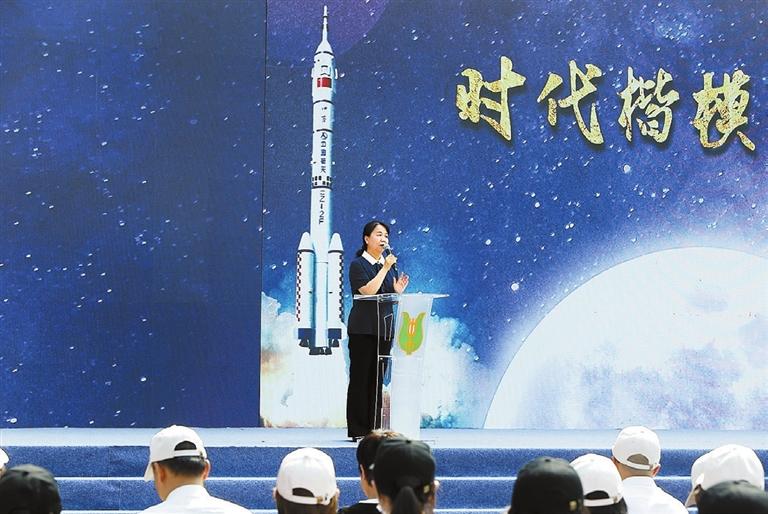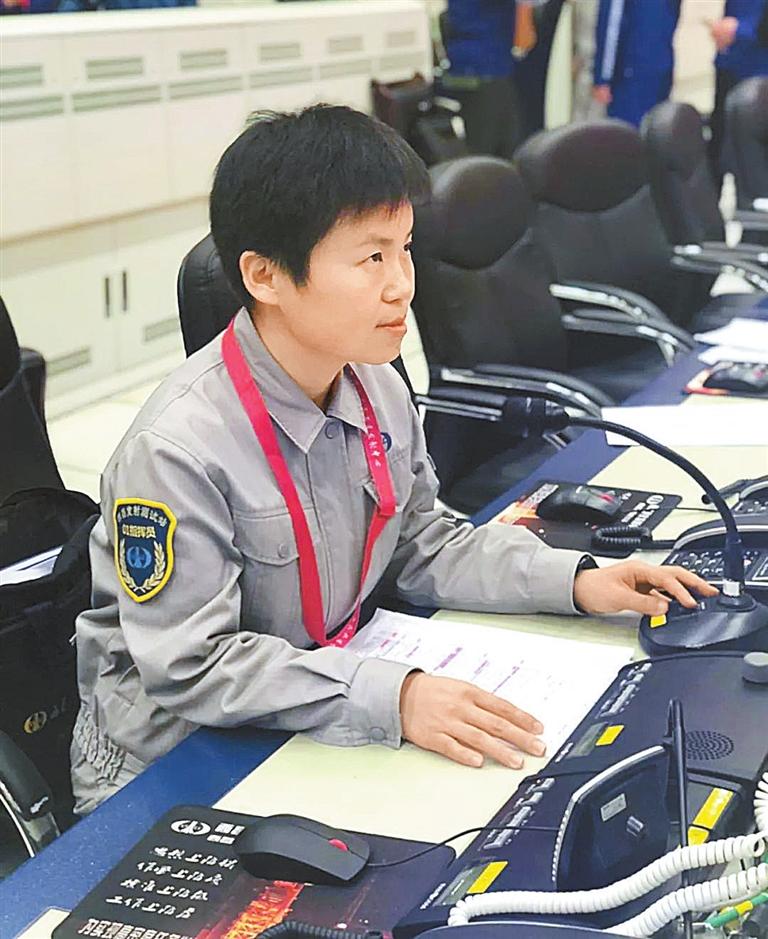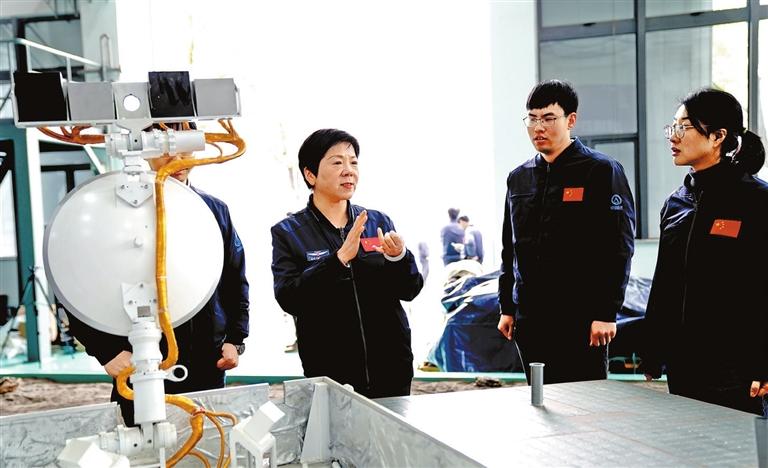




WHEN the countdown began, the world seemed to fall silent, and everyone held their breath. The only sound that echoed through the air was Zhang Runhong’s steady voice: “10, nine, eight... three, two, one, ignition!” Zhang is an “01” commander at the Xichang Satellite Launch Center in southwestern China’s Sichuan Province. She is responsible for coordinating all stages and systems involved in a rocket launch mission and ultimately issuing the final countdown and ignition commands. She is the first Chinese woman to hold this crucial position. “The ‘01’ commander is so cool!” These words resonated with Zhang when she first participated in a satellite launch as a junior staff member in 2006. From that moment on, she set her sights on becoming the one at the console — and she never hesitated to share her ambition to become an “01” commander. Even in front of Chinese President Xi Jinping, she voiced her dream with confidence. In early 2018, when Xi, also general secretary of the Communist Party of China Central Committee and chairman of the Central Military Commission, visited the military base where Zhang worked and met with staff members, she said to him, “Chairman, I have a goal — to become our country’s first female ‘01’ commander.” Xi responded with delight. “The ‘01’ commander shoulders a vital scientific mission. If you succeed, it would be a milestone for women in our country,” he said. “I hope you will achieve your goal soon.” But the path was far from easy. A commander must master technical knowledge across more than 20 subsystems and nearly 200 positions at the launch site, along with extensive hands-on experience. Every command must be issued with absolute precision in timing, as any delay could miss the narrow launch window. Determined to prove herself, Zhang cut her hair short, carried 100-pound fueling hoses just like her male colleagues, climbed the nearly 90-meter-tall launch gantry, and inspected swing arms suspended high above the ground. She systematically studied different systems and positions in her spare time, covering her room’s walls with pneumatic and electrical diagrams. Night after night, she stayed up late poring over technical manuals, protocols, and contingency plans. After participating in 80 launch missions, her opportunity finally came with the 81st. At midnight of Nov. 1, 2018, at the age of 36, Zhang made history as China’s first female “01” commander, directing the launch of a Long March-3B rocket that successfully carried the 41st BeiDou navigation satellite into orbit. Zhang is not alone in her contribution to China’s space exploration. A new generation of female talent, from astronauts to chief designers, is forging crucial contributions to China’s space exploration endeavors. The story of Wang Yaping, the first female astronaut to enter China’s space station, is another case in point. Her space dream was ignited in 2003 when China sent its first taikonaut Yang Liwei into space. “I watched the bright rocket flame on TV, and an idea flashed through my mind — China now has a male taikonaut, when will there be a female one?” Wang said. Through arduous efforts, she became a crew member of the Shenzhou-10 space mission in 2013. Wang, who once dreamed of being a teacher, delivered a 40-minute open class, China’s first live space lecture, from the spaceship June 20, 2013 — to over 60 million students nationwide. The impact of that lesson extended far beyond the classroom. “I’ve received many letters from children and young people. One that impressed me most was from a Beihang University postgraduate,” she recalled. This letter was written by a woman six years after she watched Wang explaining gyroscope principles from space. The woman revealed in the letter that she was studying the same principles in her university laboratory, six years after seeing Wang delivering her class. “This is the very meaning of our space class — to plant the seeds of scientific and space dreams in children’s hearts,” Wang said. In November 2021, meanwhile, Wang’s extravehicular activities during the Shenzhou-13 mission made her the first Chinese female to conduct a spacewalk. Her achievements, notably, are paved with the same rigorous training undertaken by male astronauts. Wang said that space has never changed its environment or lowered its threshold because of the arrival of women — and that ample flight data show that there are no significant differences between males and females in their ability to adapt and work in space. “It is the concept of gender equality that has given me the opportunity to carry out two space flight missions and realize my dreams,” Wang noted. “It is conceivable that more and more women will participate in manned spaceflight missions. It will have a very important impact on the large-scale and long-term human exploration of space in the future.” Standing firmly behind astronauts like Wang is another woman — Huang Weifen, chief designer of the China manned space program’s astronaut system. In 1992, when China’s manned space program was officially approved, the task of selecting and training astronauts fell to the then 28-year-old Huang. With no existing system to follow, she designed China’s first comprehensive astronaut training plan in just three months — a blueprint that laid the foundation for the nation’s astronaut preparation efforts for over two decades. Under Huang’s stewardship, a sophisticated training regime encompassing over 100 subjects across eight categories was developed. The pioneering nature of her work brought immense challenges, and Huang has admitted to moments of tears behind closed doors. “But after crying, I would go back to work with full force, solving one problem after another. Thinking that I am doing this for the country and the nation, I immediately feel revived. I have never thought of giving up.” Her task, though not in the public eye, is her driving force. “My mission is to cultivate more and better astronauts for the country, to enable them to fly with our dreams and complete hard work,” she said. “Safeguarding their spaceflight is my purpose.” The list of China’s female contributors to the country’s space quest is long. In June 2012, Liu Yang became China’s first female taikonaut, completing a 13-day space mission. “You are truly a heroine, an example of how women hold up half the sky,” said President Xi, praising Liu when he met her months later on the sidelines of the annual session of the national legislature and calling her an “ambassador” representing Chinese women. In June 2022, Liu embarked on her second space mission aboard Shenzhou-14. The list also includes the likes of Zhang Yuhua, deputy commander-in-chief of the Chang’e-5 lunar probe system and deputy commander of the Tianwen-1 Mars probe. “As the Chinese people pursue a happy life, every Chinese woman has the opportunity to excel in life and make their dream come true,” President Xi said when he addressed the Global Leaders’ Meeting on Gender Equality and Women’s Empowerment at the U.N. headquarters in New York a decade ago.(Xinhua) | 
